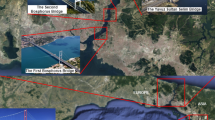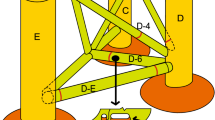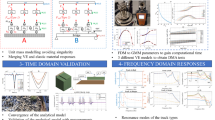Abstract
Since their geometrical structure is different to the ordinary line track, crossings are sensitive to failure and can be damaged easily by the train wheel. In this research paper, the existing failures of switches and crossings have been discussed. The aim of this study is improving the maintenance trend of standard switch rails and crossings by analyzing the existing failures and their effects. To conduct this study the failure mode and effects and criticality analysis (FMECA) method has been employed with appropriate techniques. The failure mode, effects and criticality analysis (FMECA) model helps to understand the most critical failures by categorizing based on their risk priority number. From the results of the analysis six failure modes have been laid under high risk categories whereas two failure modes have been laid under moderate risk categories and four failure modes have been laid under low risk categories. In the end it is possible to conclude that the failure modes under high risk category need special attention during maintenance planning and need improvement in the previous rectification techniques.






Similar content being viewed by others
Change history
11 October 2023
A Correction to this paper has been published: https://doi.org/10.1007/s11668-023-01780-y
References
J.Y. Shih, P. Weston, M. Entezami, C. Roberts, Dynamic characteristics of a switch and crossing on the West Coast main line in the UK. Rail. Eng. Sci. 30(2), 183–203 (2022)
C. Hegedűs, P. Ciancarini, A. Frankó, A. Kancilija, I. Moldován, G. Papa, P. Varga, Proactive maintenance of railway switches. 2018 5th international conference on control, decision and information technologies (CoDIT), IEEE, 2018, pp. 725–730
M. Szkoda, G. Kaczor, Application of FMEA analysis to assess the safety of rail vehicles. 23rd International Symposium EURO–ZEL, 2015
M. Szkoda, M. Satora, The application of failure mode and effects analysis (FMEA) for the risk assessment of changes in the maintenance system of railway vehicles. Tech. Trans. 116(8), 159–171 (2019)
C. Nadal Reales, Reliability, availability and maintainability study of a light rail transit system, Bachelor's thesis, Universitat Politècnica de Catalunya, 2014
M. Hamadache, S. Dutta, O. Olaby, R. Ambur, E. Stewart, R. Dixon, On the fault detection and diagnosis of railway switch and crossing systems: an overview. Appl. Sci. 9(23), 5129 (2019)
S. Jalili Hassankiadeh, Failure analysis of railway switches and crossings for the purpose of preventive maintenance, 2011
Z.A. Bukhsh, A. Saeed, I. Stipanovic, A.G. Doree, Predictive maintenance using tree-based classification techniques: a case of railway switches. Transp. Res. Part C Emerg. Technol. 101, 35–54 (2019)
M.J. Rahimdel, B. Ghodrati, Risk prioritization for failure modes in mining railcars. Sustainability. 13(11), 6195 (2021)
Y. Deng, L. Song, J. Zhou, N. Xu, G. Ni, L. Wang, Analysis of failures and influence factors of critical infrastructures: a case of metro. Adv. Civ. Eng. 2020, 1–13 (2020)
A. Cornish, Life-time monitoring of in service switches and crossings through field experimentation, Doctoral dissertation, Imperial College London, 2014
R. Borgovini, S. Pemberton, M. Rossi, Failure mode, effects, and criticality analysis (FMECA) (Reliability Analysis Center, London, 1993), p.1993
G. Papa, Š Poklukar, A. Frankó, A. Sillitti, A. Kancilija et al., Improving the maintenance of railway switches through proactive approach. Electronics. 9(8), 1260 (2020)
I. Grossoni, P. Hughes, Y. Bezin, A. Bevan, J. Jaiswal, Observed failures at railway turnouts: failure analysis, possible causes and links to current and future research. Eng. Fail. Anal. 119, 104987 (2021)
N. Dadashi, D. Golightly, S. Sharples, Modelling decision-making within rail maintenance control rooms. Cogn. Technol. Work. 23, 255–271 (2021)
F. Dinmohammadi, B. Alkali, M. Shafiee, C. Bérenguer, A. Labib, Risk evaluation of railway rolling stock failures using FMECA technique: a case study of passenger door system. Urban Rail Transit. 2, 128–145 (2016)
K.J. Bryan, M. Solomon, E. Jensen, C. Coley, K. Rajan, C. Tian, N. Mijatovic, J.M. Kiss, B. Lamoureux, P. Dersin, A.O. Smith, Classification of rail switch data using machine learning techniques. ASME Joint Rail Conference, Pittsburgh, PA, 2018
S. Jalili Hassankiadeh, Failure analysis of railway switches and crossings for the purpose of preventive maintenance. KTH Architecture and the built Environment, Stockholm, 2011
R. Meesit, P. Phornthepkasemsant, R. Rattanawan, T. Ruamsab, Risk assessment of railway switch and crossing failures: case study of an urban rail transit in Thailand. Urban Rail Transit. 10, 557–566 (2022)
A. P. D. Souza, F.M. Tavares, R.T.R. Bonikowski, V.H.M. Pereira, Reduction of number of railroad accidents with locomotive as the main cause. International certification in management of rail and metro rail systems, Brasília, 2019
M.A. Spiroiu, M. Nicolescu, Failure modes analysis of railway wheel. MATEC Web Conf. 178, 06005 (2018)
Acknowledgment
Mainly the author would like to Grant thanks to African Center of Excellence (ARCE) for awarding me the scholarship to study PhD degree in rolling stock engineering in the center. This research work has been supported by Addis Ababa Institute of Technology, African Railway Center of Excellence and World Bank group. The author would also want to acknowledge her advisor Dr. Daniel Tilahun for his unlimited assistance and resource-full guidance that encouraged the researcher to conduct the research effectively and courageously.
Author information
Authors and Affiliations
Corresponding author
Additional information
Publisher's Note
Springer Nature remains neutral with regard to jurisdictional claims in published maps and institutional affiliations.
Rights and permissions
Springer Nature or its licensor (e.g. a society or other partner) holds exclusive rights to this article under a publishing agreement with the author(s) or other rightsholder(s); author self-archiving of the accepted manuscript version of this article is solely governed by the terms of such publishing agreement and applicable law.
About this article
Cite this article
Minwuyelet, R., Tilahun, D. Failure Modes Effects and Criticality Analysis of Switch Rails and Crossings Toward Maintenance Improvement: A Case Study of Addis Ababa Light Rail Transit. J Fail. Anal. and Preven. 23, 1194–1202 (2023). https://doi.org/10.1007/s11668-023-01670-3
Received:
Revised:
Accepted:
Published:
Issue Date:
DOI: https://doi.org/10.1007/s11668-023-01670-3




